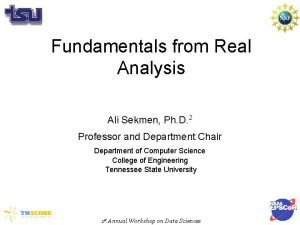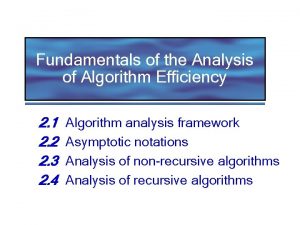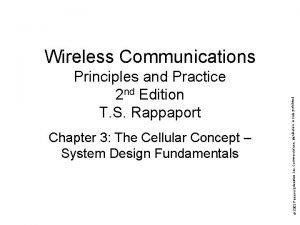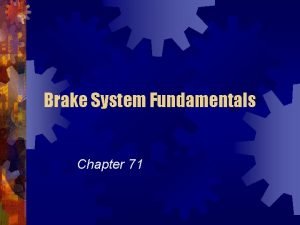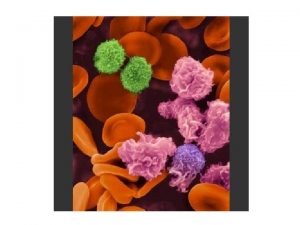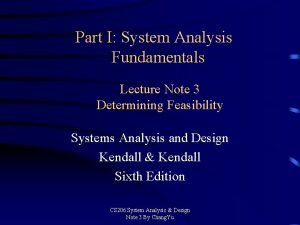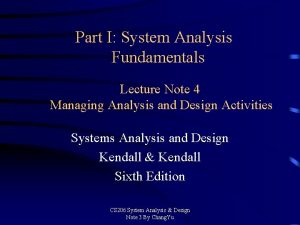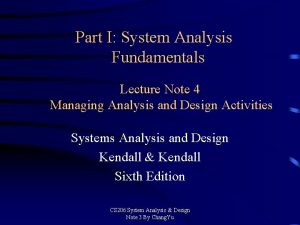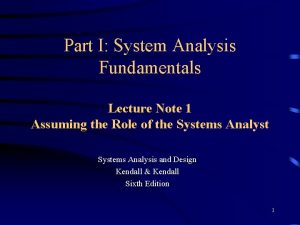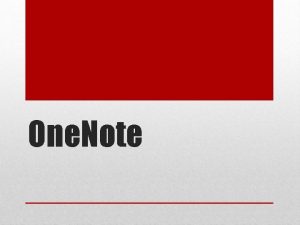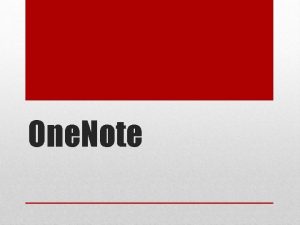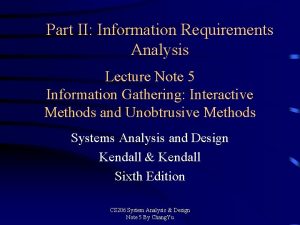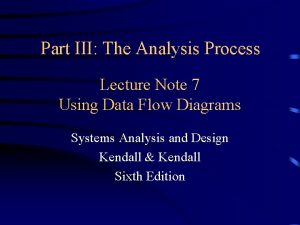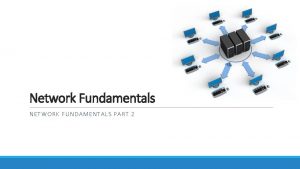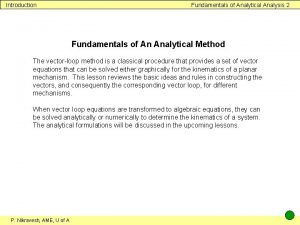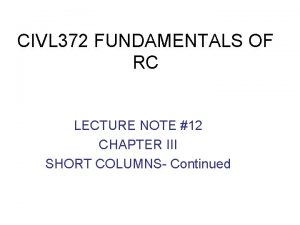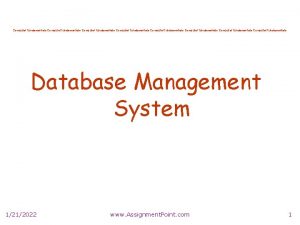Part I System Analysis Fundamentals Lecture Note 2






































- Slides: 38

Part I: System Analysis Fundamentals Lecture Note 2 Understanding Organizational Style and Its Impact on Information Systems Analysis and Design Kendall & Kendall Sixth Edition CS 206 System Analysis and Design Note 2 By Chang. Yu

Major Topics • • • Analytical skills for systems analysts System Thinking Organizational environment Context-level Data Flow Diagram Entity-relationship Diagram Levels of management CS 206 System Analysis and Design Note 2 By Chang. Yu 2

Succeeding as a Systems Analyst • An successful SA should have: 1. Interpersonal skills 2. Analytical skills 3. Management skills 4. Technical skills The relationship between a system analyst’s skills and the systems development life cycle. CS 206 System Analysis and Design Note 2 By Chang. Yu 3

Interpersonal Skill • Interpersonal skill: It is important to establish and maintain good working relationships with clients and colleagues by effective communication. Skills could be improved by experience alone. • Gathering information may be achieved by conduction interviewing, listening and questionnaires. • Written or oral presentations will be used during the project development process. CS 206 System Analysis and Design Note 2 By Chang. Yu 4

Analytical Skill • Analytical skill: The ability to see things as system. That means SA should be able to have system thinking when they analysis a system. 1. System thinking: subsystem, interrelated, procedures, input, output. . . 2. Organizational knowledge: company operation, knowledge on functions, internal policies, environment. 3. Problem identification: compare current results and predictable results so as to identify problems. 4. Problem analyzing and solving: collect data, project design, test system and choose best solution. CS 206 System Analysis and Design Note 2 By Chang. Yu 5

Management Skills Management skills: 1. Resource Management: Arrange the most suitable resources of a project development. 2. Project Management: Control the project finished on time and within the budget. SA can keep track with the whole project’s progress in order to achieve the goal. 3. Risk Management: have ability of prediction (預報) on what might go wrong in a project and use the knowledge and skills to prevent (阻止) them. 4. Change Management: SA is the agent of change, which aims at creating a most smooth and effective system for users. CS 206 System Analysis and Design Note 2 By Chang. Yu 6

Technical Skills • Technical skills: SA should keep their skills up-todate and understand a wide variety of technologies required. – – – – The different kinds of computers Programming languages Operating systems Database and file management systems Data communication standards Systems development tools and environments Web development languages and tools Decision support system generators. CS 206 System Analysis and Design Note 2 By Chang. Yu 7

System Thinking • System: An interrelated set of components, with an identifiable boundary, working together for some purpose. A system has nine characteristics: 1. Component (Subsystem) 2. Interrelated subsystems, 3. Boundary, 4. Purpose, 5. Environment, 6. Interface, 7. Input, 8. Output, 9. Constrains. A general depiction of a system CS 206 System Analysis and Design Note 2 By Chang. Yu 8

• Subsystem: An irreducible (不可減少的) part or aggregation of parts that make up a system. • Interrelated subsystem: Dependence of one subsystem on one or more subsystem. • Boundary: The line that marks the inside and outside of a system and that sets off the system from its environment. • Purpose: The overall goal or function of a system. • Environment: Everything external to a system that interacts with the system. • Interface: Point of contact where a system meets its environment or where subsystems meet each other. • Constraint: A limit to what a system can accomplish. • Input: whatever a system takes from its environment in order to fulfil its purpose. • Output: whatever a system returns to its environment in order to fulfil its purpose. CS 206 System Analysis and Design Note 2 By Chang. Yu 9

Apply System Thinking to Information System • Thinking of organizations as system is a useful perspective from which to begin developing information systems. • Information systems can be seen as subsystems in larger organizational systems, taking input from, returning output to and their organizational environments. CS 206 System Analysis and Design Note 2 By Chang. Yu 10

Organizations • To analyze and design appropriate information systems, systems analysts need to comprehend the organizations: – The levels of management – Design of organizations – The organizational cultures • Organizations are composed of smaller – interrelated system: departments, units and divisions, … – interdependent subsystems. Serving specialized functions : accounting, marking, production, data process and management. • System and subsystem boundaries and environments impact on information system analysis and design. – How smaller systems are involved. – How they function. – What it’s environment CS 206 System Analysis and Design Note 2 By Chang. Yu 11

Interrelatedness and interdependence of systems • All system and subsystem are interrelated and interdependent – When any element of a system is changed or eliminated, the rest of the system’s elements and subsystems are also significantly affect. • All system are contained by boundaries separating them from their environments. – Organizations must be able first to import people, raw materials and information through their boundaries (input), then to exchange their finished products, services or information with the outside world (output). – Feedback • Is useful for system planning and control. • It is received from within the organization and from the outside environment around it. It is self-corrects. It helps administrators formulate more specific goals as inputs. CS 206 System Analysis and Design Note 2 By Chang. Yu 12

This figure Shows how system outputs are used as feedback that compares performance with goals. This comparison in turn helps administrators formulate more specific goals as inputs. Italian knitwear company that markets its clothing in USA. Computerized Inventory Information System Find out what colors are selling best and dyes (染色) sweaters (衛生衣) in hot-selling colors immediately before shipping them. For production planning: Account current & projected demand formulates a proposed solution CS 206 System Analysis and Design Note 2 By Chang. Yu 13

Organizational Environment Anything external to an organization’s boundaries is considered to be an environment. • Community environment – Size of its population and physical location. – Factors such as education, income. • Economic environment – Market factors – Competition • Political environment – State and local government CS 206 System Analysis and Design Note 2 By Chang. Yu 14

Open and Closed Systems • A key aspect (方面) of a system for building is the system’s relationship with its environment. • There is no such thing as an absolutely open or completely closed organization. • Systems are described as either – Open system : interacts freely with its environment, taking input and returning output. (such as creative, art departments, library, information system are characterized as open. ) • Free-flowing information within the organization. As environment changes an open system must adapt (使适合) to change. • Output from one system becomes input to another. – Closed system: is cut off from its environment and does not interact with it. (such as defense (防衛) department unit assigned to work on top-secret defense planning affecting national security. ) • Limited by numerous (許多) rules. • Information on a need to know basis. 15

Taking a Systems Perspective • Taking a system perspective allows systems analysts to start broadly (寬闊的) clarifying and understanding the various business with which they will come into contact. • It is important that members of subsystems realize that their work is interrelated. Neither subsystem can accomplish its goals without the other. CS 206 System Analysis and Design Note 2 By Chang. Yu 16

• Problem occur when each manager possesses a different picture of the importance of his or her own functional subsystem. • If a production manager is promoted but continues to stress (着重) production scheduling and performance of line workers, the broader aspects of forecasting (預測) and policy making may suffer. • This tendency is a danger in all sorts of businesses. Their tunnel vision often creates problems for the systems analyst trying to separate actual informational requirements from desires (期望) for a particular kind of information. CS 206 System Analysis and Design Note 2 By Chang. Yu 17

Example: A fast food restaurant ‘Hoosier Burger’ as a system. 1. Physical subsystems: kitchen, dining room, counter, storage and office. 2. The subsystems are interrelated and work together to prepare food and deliver it to customers. 3. The boundary of Hoosier Burger is represented by its physical walls. 4. One purpose is to make a profit (利潤) for its owners. 5. Environment: customers, food distributors, bank, local labor supply and neighbourhood fast food competitors. 6. Interface: at the counter where customers place orders and another at the back door where food and supplies are delivered. Still another is the telephone manager use regularly to talk with bankers and food distributors. 7. Input: food, labor and cash. 8. Output: prepare food bank deposits and trash (廢棄物). 9. Constraints: the restaurant in the foods it may offer for sale, how much money it can make on any given day, Rules governing food storage.

Summary: Using a systems to understand organizations allows to : – Acknowledge (承認) the idea of systems composed of subsystems, – Their interrelatedness and their interdependence, – The existence of boundaries that allow or prevent ( 防止) interaction between various departments and elements of other subsystems and environments. – The existence of internal environments, characterized by degrees of openness and closed ness, which might differ (不同) across departments, units, or even projects. CS 206 System Analysis and Design Note 2 By Chang. Yu 19

Enterprise Resource Planning • Enterprise Resource Planning (ERP) describes an integrated organizational (enterprise) information system. • EPR is software helps the flow of information between the functional areas within the organization. • ERP systems include : – – – – Manufacturing components Capacity planning Material production scheduling Forecasting. Sales and operations planning Distribution Managing the supply chain. CS 206 System Analysis and Design Note 2 By Chang. Yu 20

Context-Level Data Flow Diagram (DFD) An Environment Model A system or subsystem may be graphically depicted in several ways. The various graphical models show the boundaries of the system and the information used in the system. • A context-level data flow diagram is an important tool for showing data used and information produced by a system. • It provides an overview of the setting or environment the system exists within: which entities supply and receive data/information. • It shows how data moves through an information system. DFD represent a logical model that shows what the system does, not how it does it. CS 206 System Analysis and Design Note 2 By Chang. Yu 21

Relationships • Relationships show the entities are connected. • Degrees of relationship: the number of entity types that participate in that relationship. • There are three types of relationships: – – Cardinalities: One to one. One to many. Many to many. Mandatory one • Relationship Notations CS 206 System Analysis and Design Note 2 By Chang. Yu Mandatory many Optional one Optional many 22

• A process receives input data and produces output information. • Context level has only one process, representing the entire system. • Process, representing the entire system. It is given the number 0. • An Entity is labeled with a noun. Customer • Data flow, represented by an arrow. Travel Request • Data flow is labeled with a noun. CS 206 System Analysis and Design Note 2 By Chang. Yu 23

Data Flow Example 1 The passenger (an Entity) initiates a travel request (data flow). The context level diagram doesn’t show enough detail to indicate exactly what happens, but we can see that the passenger’s preferences (偏愛) and the available flights are sent to the travel agent, who sends ticketing information back to the process. We can also see that the passenger reservation is sent to the airline. CS 206 System Analysis and Design Note 2 By Chang. Yu 24

A Fast Food Restaurant’s Customer Order Information System depicted in a data flow diagram. Data Flow Example 2 Four subsystems: • Process Customer Food Order • Update Goods Sold File • Update Inventory File • Produce Management Report The arrows show these subsystems are interrelated. Input of the system: Customer Order. Output of the system: Receipt, Kitchen Order and Management Report. Environment : Customers, the Kitchen, and Restaurant Manager. System’s purpose is to take customer orders , send the orders to the kitchen, monitor (監視) goods sold and inventory, generate reports for management, and improve the efficiency of the restaurant’s operations. Constraints: is the system inability to provide on-line, real time information inventory level and so on.

Entity-Relationship Diagrams (E-R Diagrams) • Entity-relationship Diagrams help the analyst understand the organizational system and the data stored by the organization. • E-R Diagram consists of – Entity: Anything about which we wish to maintain information, may be a person, a place , a thing, a concept or an event. – Relationship: is the association that describes the interaction among the entities. – Attribute: Property or characteristic of an entity type. Data attributes may be added to the diagram. CS 206 System Analysis and Design Note 2 By Chang. Yu 26

There are three types of entities: 1. Fundamental entity • • Symbol is a rectangle. Be labeled with a noun. 2. Associative entity, linking entities. • • • Joins two entities. Can only exist between two entities. Symbol is a diamond inside a rectangle. 3. Attributive entity, to describe attributes and repeating groups. - Describes attributes and repeating groups. - Symbol is an oval in a rectangle. CS 206 System Analysis and Design Note 2 By Chang. Yu 27

1. An EMPLOYEE is assigned to one OFFICE. 2. An OFFICE is occupied by one EMPLOYEE. 1. One CARGO AIRCRAFT will serve one or more DISTRIBUTION CENTERs. 2. One or more DISTRIBUTION CENTERs are served by one CARGO AIRCRAFT. 1. A SYSTEM ANALYST is assigned to zero or many PROJECTs. 2. Zero or many PROJECTS will be developed by one SYSTEMS ANALYST. CS 206 System Analysis and Design Note 2 By Chang. Yu 28

1. A MACHINE is undergoing zero or more SCHEDULED MAINTENANCE. 2. Zero or more SCHEDULE MAINTENANCE are being done to one MACHINE. 1. One or many SALESPEOPLE are assigned to one or many CUSTOMER. 2. One or many CUSTOMERs are called on by one or many SALESPEOPLE. 1. Many PASSENGERs are flying to many DESTINATIONs. 2. Many DESTINATIONs will be visited by many PASSENGERs. 1. Zero or many HOME OFFICEs have one or many EMPLOYEE, 2. One or many EMPLOYEE are assigned to zero or many HOME OFFICEs. CS 206 System Analysis and Design Note 2 By Chang. Yu 29

Another Entity Relationship Examples • Exactly one employee is assigned to one phone extension. No one shares the phone extension in this office. • The red arrows are not part of the entity-relationship diagram. They are present to demonstrate how to read the E-R diagram. 30

The red arrows are not part of the entityrelationship diagram. They are present to demonstrate how to read the E-R diagram. CS 206 System Analysis and Design Note 2 By Chang. Yu 31

Creating Entity-Relationship Diagrams • • Entity-Relationship (E-R) Diagrams are used by system designers to help model the file / database. Steps used to create E-R diagrams: – List the entities in the organization to gain a better understanding of the organization. – Choose key entities to narrow the scope of the problem. – Identify what the primary entity should be. – Confirm (確定) the results of the above through data gathering methods (investigation, interviewing, administering questionnaires, observation, prototyping). . • E-R diagrams help the SA • To understand what business the organization is actually in. • To determine the size of the problem. • To discern (識別) if the right problem is being addressed. • E-R diagrams need to be confirmed / revised as the data-gathering process takes place. CS 206 System Analysis and Design Note 2 By Chang. Yu 32

Levels of Management The three levels of managerial control are: 1. Operations management. 2. Middle management. 3. Strategic management. Each level carries its own responsibilities and all work toward achieving organizational goals and objectives in their own ways. CS 206 System Analysis and Design Note 2 By Chang. Yu 33

Operations Management • Operations manager make decisions using predetermined rules that have predictable (可預測的) outcomes when implemented correctly. • Management make decisions that affect implementation in work scheduling, inventory control, shipping, receiving, and control of processes. Operation managers oversee the operating details of the organization. • To ensure that the basic tasks of the organization are accomplished on time and in accordance (一致) with organizational constraints. Implications for Operations Manager: – Dependent on internal information that is of a repetitive, low-level nature. – Highly dependent on information that captures current performance. – Large uses of on-line, real-time information resources. – Past performance information and periodic (定期的) information is only moderate (穩定的). – They have little use for external information that allows future projections. . 34

Middle Management • Makes short-term planning & control decisions about how resources may best be allocated to meet organizational objectives. • Decisions are dependent on internal information, both historical and prediction oriented. • Their decision range all the way from forecasting future resource requirements to solving employee problem that threaten (威脅) productivity. • Decisions may be partly operational and partly strategic. Implications for Middle Manger: – – – Need both short- & longer-term information. Highly need for information in real time Current information on performance. Highly dependent on internal information. Highly need for historical information, along with information that allows prediction of future events. CS 206 System Analysis and Design Note 2 By Chang. Yu 35

Strategic Management • Look outward from the organization to the future. • Make decisions that will guide middle and operations managers. • Work in highly uncertain decision-making environment. • Define statements of goals and the determination of strategies & policies to achieve them. (E. g. develop new product lines, acquire (獲得) other compatible companies. ) Implications for strategic Manager: – Highly dependent on information from external sources that supply news of market trends and the strategies of competing corporations. – Need for information of a predictive nature. – Need for periodically reported information. – Need general , summarized information. – Need qualitative (質量上的) information, mainly from external sources. CS 206 System Analysis and Design Note 2 By Chang. Yu 36

Managerial Levels Each of the three levels of management have: • Different organization structure. • Leadership style. • Technological considerations (考慮). • Organization culture. • Human interaction. • All carry implications for the analysis and design of information systems. CS 206 System Analysis and Design Note 2 By Chang. Yu 37

Questions • • • What skills an successful SA should be have ? What is the system thinking? Define openness and closeness in an organizational environment. What is the main purposes for drawing a DFD and E-R Diagram ? List the three broad, horizontal levels of management in organizations. CS 206 System Analysis and Design Note 2 By Chang. Yu 38
 01:640:244 lecture notes - lecture 15: plat, idah, farad
01:640:244 lecture notes - lecture 15: plat, idah, farad Lecture note tiu
Lecture note tiu Difference between note making and note taking
Difference between note making and note taking Signal phrases
Signal phrases Difference between note making and note taking
Difference between note making and note taking Financial documents order
Financial documents order Draw a specimen of debit note
Draw a specimen of debit note Debit note là gì
Debit note là gì Note taking definition
Note taking definition Simple discount formula
Simple discount formula Power system analysis lecture notes
Power system analysis lecture notes According to walter pauk, 10 weeks after lecture
According to walter pauk, 10 weeks after lecture Hilbert space
Hilbert space Fundamentals of analysis of algorithm efficiency
Fundamentals of analysis of algorithm efficiency Exploratory data analysis lecture notes
Exploratory data analysis lecture notes Sensitivity analysis lecture notes
Sensitivity analysis lecture notes Factor analysis lecture notes
Factor analysis lecture notes Analysis of algorithms lecture notes
Analysis of algorithms lecture notes Streak plate method performed on
Streak plate method performed on Addition symbol
Addition symbol Part to part ratio definition
Part to part ratio definition Brainpop ratios
Brainpop ratios What is technical description
What is technical description Footed ware glassware
Footed ware glassware The phase of the moon you see depends on ______.
The phase of the moon you see depends on ______. Part to part variation
Part to part variation Cellular system design fundamentals
Cellular system design fundamentals Brake system fundamentals
Brake system fundamentals What are the characteristics of nervous tissue
What are the characteristics of nervous tissue Fundamentals of information systems
Fundamentals of information systems Sensory input and motor output
Sensory input and motor output Neuron processes
Neuron processes Chapter 23 computer system fundamentals
Chapter 23 computer system fundamentals Power system dynamics and stability lecture notes
Power system dynamics and stability lecture notes Operating systems lecture notes
Operating systems lecture notes Health management information system lecture notes
Health management information system lecture notes Lymphatic
Lymphatic Power system dynamics and stability lecture notes
Power system dynamics and stability lecture notes Note card system
Note card system












